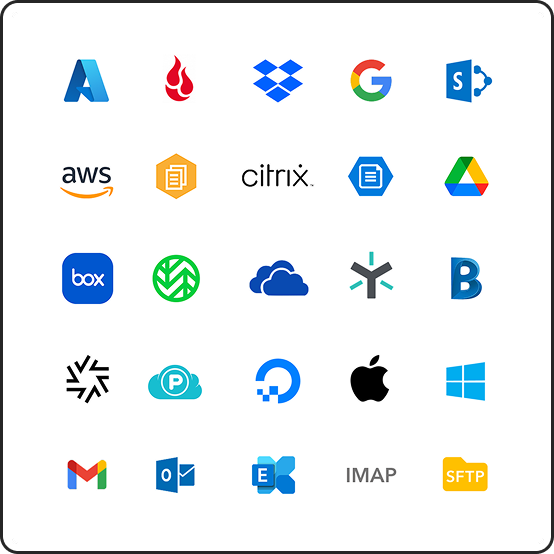There are a lot of AI tools these days, and new features are being released constantly aimed at making repetitive tasks simpler or completely automated. Having AI handle some of these tasks that human users hate doing without losing any accuracy or precision is a benefit most business owners and workers would be happy to have. However, in order for AI tools to work efficiently, the data they have access to has to be in the right state so the AI can understand it and provide you with quality results. So what do you need to have data in the right state, and how can you restructure data to leverage AI?

AI ready data
In order to take advantage of AI, the data needs to be “AI ready”, meaning that it’s in a format that AI can make use of. This isn’t a particular file format or style, but instead refers to elements like metadata and having the right access levels.
For example, suppose there’s a folder of confidential files reserved for company board members. Every file and subfolder should have access restricted to the right people. But if for some reason it isn’t, like if a mistake was made at some level so other users have access, the AI tool could search those files when returning a response to a query and use the information inside as a source.
There are a few things that should be done in order to make sure that the data is ready to implement AI. For more information on this, see our article What is AI ready data?
Ways to restructure data for AI
Depending on what shape the data is in, there may need to be some major changes that need to be done before integrating an AI tool. Sometimes, restructuring at scale is the best way to make sure the data is ready for AI. There are several ways to do this such as labeling sensitive data, archiving data, and migrating data to different platforms or locations.
Labeling sensitive data
Part of the onboarding for an AI like Copilot is preparing data with appropriate labels. A lot of AI prep guides will have this as a small bullet point, but it can actually be a massive undertaking with massive ramifications if it's skipped over, ranging from the tool being ineffective to breaking compliance.
One of the biggest risks of using AI is having it accidentally expose sensitive data. This mostly happens due to user error or mislabelling as opposed to the AI circumventing restrictions. Using Microsoft as an example, there is the option to use sensitivity labels where the restriction applies to Copilot as well. For example, if a user requests information contained in a document they don't have access to, data from the document won't be able to be extracted if sensitivity labels are properly used.
Of course, this is assuming that the sensitive data labels are being used, and not that the data is being restricted in another way. Fortunately with Microsoft, if they aren't currently being used, the labels can be applied to entire folders in storage like SharePoint and it will affect the contents inside (except for any files currently open) so you can quickly update labels at scale
Modifying and cleaning data
The results from AI are only as good as the dataset, so garbage data sets will spit that right back out. High data quality is crucial for a solid AI integration, and there are a few things that can be done to improve data quality for AI.
Related to labeling sensitive data, if there’s data that should be abiding by best practices for compliance like GDPR but currently isn’t, make sure to make changes so that it does. The AI shouldn’t be able to return results to users who shouldn’t have access due to compliance, so it’s important to make sure this is the case. If not, those files should be updated so they meet the standards.
Cleaning up the data is another way to improve it for AI usage. Data that is outdated, corrupt, poorly-formated, or duplicated isn’t particularly useful, but will still be analyzed and used by the AI tool if it’s accessible. Of course, access to these files is likely to give less useful results, so cleaning up can help both for storage efficiency and to improve results from AI tools.
Modifying and cleaning up data can help ensure users get the best results, and can potentially help save on storage costs too.
Archiving data
Another way to make sure you have AI ready data is to reorganize data, especially archiving old files. AI models train on the data that is available to them. As mentioend above, giving them access to old, outdated information means there's a chance that data will be used to give a response when you create a query. One way you can be more confident in getting good results is by limiting the availability to high-quality, recent content.
If a SharePoint site hasn't been touched for years, for instance, there's a good chance that the information in there isn't crucial, at least not for daily operations. Archiving that information will reduce storage usage and help with decluttering while keeping information available if needed.
Microsoft recently released Microsoft 365 Archive to the general public. With this method, you can move data in SharePoint to a cold storage tier still within SharePoint. When using Microsoft 365 Archive, the organization has a separate archive storage amount separate from active storage limits.
But what if you don't need or want the data where it currently is? Whether that’s a different SharePoint site, tenant, or an entirely different cloud storage account like Wasabi which has lower data rates and can help significantly lower costs long term, migrating to an archival platform can greatly help clean up data.
Migrating data
In order to use some AI tools at all, the data will need to be in a cloud storage platform that supports the AI of your choice. Many of the most popular cloud storage platforms have their own AI that can be used to summarize data and provide insight into what you have stored. For instance, Google has Gemini, Egnyte has Content Intelligence, and SharePoint has Copilot, each of which has specific strengths and use cases. If there’s any one of these in particular that you want to use for your organization, the data will first need to be in the right place.
Sometimes the best way to get AI-ready data is to migrate some of it to a new platform. This can be between platforms or something like a SharePoint to SharePoint migration between tenants or even in the same tenant at scale.
For example, suppose that an organization has hundreds of sites in SharePoint. If using something Restricted SharePoint Search by limiting Copilot, the AI will only have access to specific sites. Migrating data into or out of these sites is a fast way to control access at scale, and can also help clean up your data for users at the same time.
You can use a data migration tool like Movebot to move data at scale. Movebot is a cloud-agnostic data migration tool that can move from cloud to cloud, between cloud tenants, or even large amounts of data within the same tenant. Moving data is fast, easy, and reliable with Movebot.
Using Movebot to migrate data
If you decide that migrating data is a good option, try Movebot for the fastest and simplest way to move files and mailboxes. With Movebot, you have full control of your data and can decide what files you want to move, and when.
Migrations don't have to be the whole source to the whole destination either. Instead, you can select what to move at the folder level, including entire SharePoint sites. Follow our simple 3-step PAC plan of Plan, Advance, Cutover to start moving data in minutes.
Start by planning what you want to move. You can move an entire organization, but you don’t have to. If you only need to move a chunk of data to restructure for AI, Movebot can help too, with the ability to choose what to migrate down to the folder level.
Next, connect your platforms and start running transfers. You can use Movebot to help find files to exclude or include if you haven’t done this step already. Movebot can also be used for actions like filename sanitization and renaming at scale. After choosing your settings, advance to running transfers and start moving the data.
Once the bulk of the data is moved, it’s time to plan for final cutover. Run delta migrations to move only new and updated files, then check that everything in the destination has been moved as expected.
And that’s it. It’s really that easy.
Try the simplest data migration tool
Movebot is completely SaaS and doesn't store your data. Simply connect your platforms, choose what data to move, and start the transfer–that’s all there is to it. You can find out more about specific migrations with SharePoint and Movebot in The Complete Guide to SharePoint Migrations with Movebot.
Try Movebot for yourself with 50GB free data with no credit card or sales call required. Register for an account now to start your free trial.






